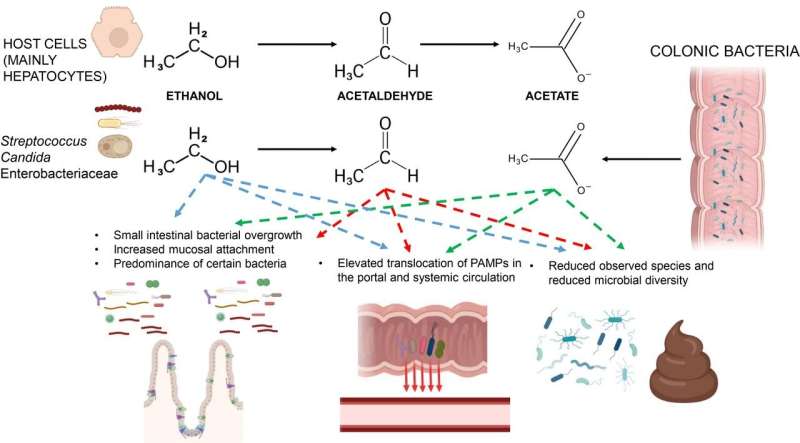This article has been reviewed according to Science X's editorial process and policies. Editors have highlighted the following attributes while ensuring the content's credibility:
fact-checked
proofread
Understanding mechanisms of alcohol-associated bowel disease

Alcohol consumption is a significant risk factor for gastrointestinal diseases, including cancer. Alcohol can damage the gastrointestinal tract in several ways. It can promote an impairment of several intestinal barrier functions, leading to leaky gut and dysbiosis. Ethanol metabolism can also produce toxic substances such as acetaldehyde and acetate, further damaging the gut and potentially promoting cancer.
Ethanol and its metabolites enhance DNA damage response and dysregulate the epithelial proliferation/differentiation program, thereby increasing the risk of cancer development.
In a new paper published in eGastroenterology, a team of scientists led by Professor Bin Gao from the National Institute of Health reviewed alcohol-associated bowel disease and the existing literature in the field.
Gastrointestinal diseases (GI diseases) are disorders of the digestive tract, which include the mouth, esophagus, stomach, small intestine, large intestine, rectum, and anus. They can also affect the accessory digestive glands, such as the liver, pancreas, gallbladder, and biliary tract.
Alcohol-associated bowel disease (ABD) is a poorly understood condition characterized by small and large intestine damage. ABD is thought to be caused by alcohol-induced damage to the gut and underlying genetic and environmental factors. The clinical diagnosis of ABD has not been defined. It may be based on alcohol drinking history, increased gut permeability, elevated systemic translocation of microbial products, and gut tissue histology.
The structural and functional changes in ABD need to be better understood. They may include pathologic changes in the intestine, such as leaky gut, changes in the intestinal epithelium, gut immune dysfunctions, and alterations in the intestinal microbiome. The pathophysiology of ABD has yet to be fully understood, but it is thought to involve the metabolism of ethanol and its principal metabolites, acetaldehyde and acetate. These metabolites can impair different functions in the digestive tract, leading to various GI diseases, including ABD.
One challenge in studying ABD is that studies are primarily descriptive. In addition, investigations of the intestinal barrier in humans often consider only advanced stages of alcohol-associated liver disease (ALD), in which additional factors such as portal hypertension or decompensation of liver function are influencing, per se, the digestive tract.
Ethanol, as well as acetaldehyde and acetate produced by ethanol metabolism in chronically alcohol abusers, may promote and/or contribute to bowel pathogenesis. Epithelial and non-epithelial cells and microbes along the different intestinal tract sites could be impacted by ethanol itself and by differential doses of acetaldehyde and acetate due to ethanol metabolism. However, the exact contribution of the digestive tract in ethanol metabolism remains to be elucidated.
More research is needed to understand ABD's mechanisms and develop effective treatments. There is some evidence to suggest that ABD may precede or contribute to ALD. For example, approximately 90% of alcohol user disorder (AUD) patients present with mild liver disease. However, most will likely have certain degrees of bowel dysfunctions (e.g., malabsorption, intestinal permeability, immune dysfunctions), suggesting that ABD may precede in certain patients and promote or contribute to ALD.
Future studies are needed to better understand the role of the intestine in ethanol metabolism and the impact of ethanol on the intestine. These studies could help identify new targets for preventing and treating ABD.
More information: Luca Maccioni et al, Alcohol-associated bowel disease: new insights into pathogenesis, eGastroenterology (2023). DOI: 10.1136/egastro-2023-100013




















